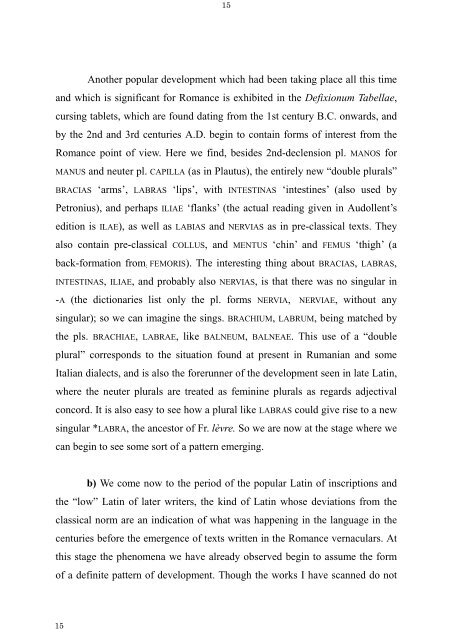The Latin Neuter Plurals in Romance - Page ON
The Latin Neuter Plurals in Romance - Page ON
The Latin Neuter Plurals in Romance - Page ON
Create successful ePaper yourself
Turn your PDF publications into a flip-book with our unique Google optimized e-Paper software.
15<br />
15<br />
Another popular development which had been tak<strong>in</strong>g place all this time<br />
and which is significant for <strong>Romance</strong> is exhibited <strong>in</strong> the Defixionum Tabellae,<br />
curs<strong>in</strong>g tablets, which are found dat<strong>in</strong>g from the 1st century B.C. onwards, and<br />
by the 2nd and 3rd centuries A.D. beg<strong>in</strong> to conta<strong>in</strong> forms of <strong>in</strong>terest from the<br />
<strong>Romance</strong> po<strong>in</strong>t of view. Here we f<strong>in</strong>d, besides 2nd-declension pl. MANOS for<br />
MANUS and neuter pl. CAPILLA (as <strong>in</strong> Plautus), the entirely new “double plurals”<br />
BRACIAS ‘arms’, LABRAS ‘lips’, with INTESTINAS ‘<strong>in</strong>test<strong>in</strong>es’ (also used by<br />
Petronius), and perhaps ILIAE ‘flanks’ (the actual read<strong>in</strong>g given <strong>in</strong> Audollent’s<br />
edition is ILAE), as well as LABIAS and NERVIAS as <strong>in</strong> pre-classical texts. <strong>The</strong>y<br />
also conta<strong>in</strong> pre-classical COLLUS, and MENTUS ‘ch<strong>in</strong>’ and FEMUS ‘thigh’ (a<br />
back-formation from: FEMORIS). <strong>The</strong> <strong>in</strong>terest<strong>in</strong>g th<strong>in</strong>g about BRACIAS, LABRAS,<br />
INTESTINAS, ILIAE, and probably also NERVIAS, is that there was no s<strong>in</strong>gular <strong>in</strong><br />
-A (the dictionaries list only the pl. forms NERVIA, NERVIAE, without any<br />
s<strong>in</strong>gular); so we can imag<strong>in</strong>e the s<strong>in</strong>gs. BRACHIUM, LABRUM, be<strong>in</strong>g matched by<br />
the pls. BRACHIAE, LABRAE, like BALNEUM, BALNEAE. This use of a “double<br />
plural” corresponds to the situation found at present <strong>in</strong> Rumanian and some<br />
Italian dialects, and is also the forerunner of the development seen <strong>in</strong> late <strong>Lat<strong>in</strong></strong>,<br />
where the neuter plurals are treated as fem<strong>in</strong><strong>in</strong>e plurals as regards adjectival<br />
concord. It is also easy to see how a plural like LABRAS could give rise to a new<br />
s<strong>in</strong>gular *LABRA, the ancestor of Fr. lèvre. So we are now at the stage where we<br />
can beg<strong>in</strong> to see some sort of a pattern emerg<strong>in</strong>g.<br />
b) We come now to the period of the popular <strong>Lat<strong>in</strong></strong> of <strong>in</strong>scriptions and<br />
the “low” <strong>Lat<strong>in</strong></strong> of later writers, the k<strong>in</strong>d of <strong>Lat<strong>in</strong></strong> whose deviations from the<br />
classical norm are an <strong>in</strong>dication of what was happen<strong>in</strong>g <strong>in</strong> the language <strong>in</strong> the<br />
centuries before the emergence of texts written <strong>in</strong> the <strong>Romance</strong> vernaculars. At<br />
this stage the phenomena we have already observed beg<strong>in</strong> to assume the form<br />
of a def<strong>in</strong>ite pattern of development. Though the works I have scanned do not









